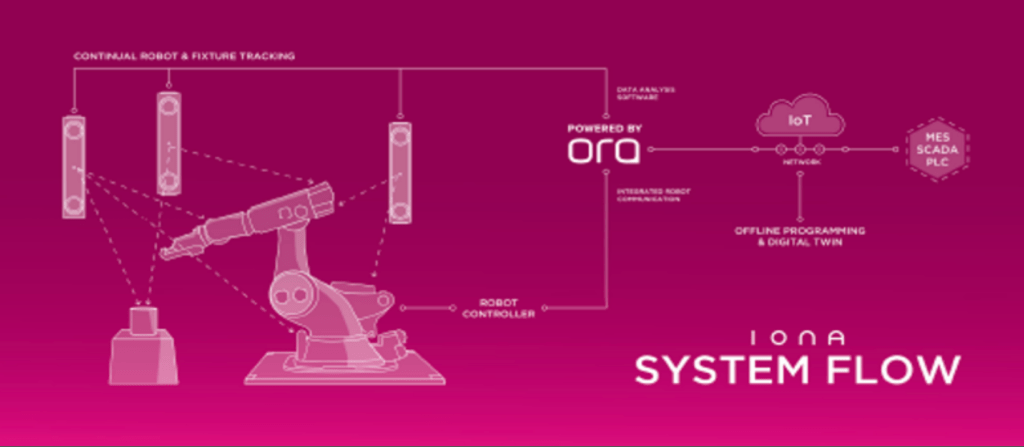We’re delighted to announce the latest version of our ORA software platform. This simplifies the integration of dimensional coordinate data with industrial robots to improve alignment, accuracy and process control of automated production.
ORA works as part of the IONA system, our flagship product that enables real-time tracking and correction of automated manufacturing processes utilising industrial robots.
The latest software release allows the system to be fully integrated with the robot controller, communicating in the native robot programming language allowing the system to operate autonomously with data and corrections called up from the robot program or PLC without the need for operator intervention.
Similarly, the ORA software now integrates with the broader factory network enabling other platforms such as the MES (manufacturing execution system), digital twin simulations or SPC process control software to automatically call up data from IONA as required. This provides a truly integrated production solution that expands and simplifies how this type of unique data can be utilized to improve production.
Ben Adeline, INSPHERE CEO states – “This new version of the ORA software creates an inflection point in the simplification and accessibility of intelligent automation. It removes the need for highly skilled automation or metrology engineers and bespoke programming to fully integrate a measurement system such as IONA with the day to day operation of production robots. Manufacturers can now adopt intelligent automation and enhance production capability with a full integrated, off the shelf solution.”

What’s the benefit of IONA and how does it work?
ONA is a network of sensors that provides positional awareness to industrial robots. The result of this is:
· Automated alignment of robot to part – 20x improvement in set-up time
· Improved robot performance – 10x better process accuracy
· Enhanced process control – 100% process confidence
The system consists of a series of nodes mounted to the cell guarding that continually monitors the automation process. The ORA software transforms this data into information and functions which can then be called up by the robot controller or PLC as required by the process.
The data from IONA can be used at three key stages of manufacturing.
It can be used at the commissioning stage to correct for the differences that occur between the simulation or the offline programme and the physical setup of the cell.
This data can also be used to feed back into the digital environment to update the digital twin, meaning that there is an exact replica in the digital world as operating in the physical world.
It can also be used as a process enabler to increase the speed and accuracy of an automated process. We can achieve a better alignment between the work object and the robot itself and achieve this faster with no manual intervention.
The system can also perform a calibration in situ on the robot. This calibration can be run as a one off when a cell is first set up, or it can be run each time a process operates.
If required, IONA can be used as part of a live feedback loop, so the process is continuously correcting and iterating based on the alignment or repositioning of elements within the cell. This can improve the dynamic accuracy of a given process.
Finally, we can use our data is as part of a process control approach. By continually monitoring a process over time we can start to spot the trends in the data and understand whether our process is about to drift out of control. Corrective actions can then be taken before it produces an incorrect part.
The IONA system consists of both hardware and software. The hardware is the series of nodes, the controller, the targeting everything that’s required to capture the data.
ORA is our software platform which is used to collect the data and perform analysis before feeding that data back into the system. ORA can be fully integrated autonomously providing data and set functions via an API to the robot controller or can be manually operated via a graphical user interface.


